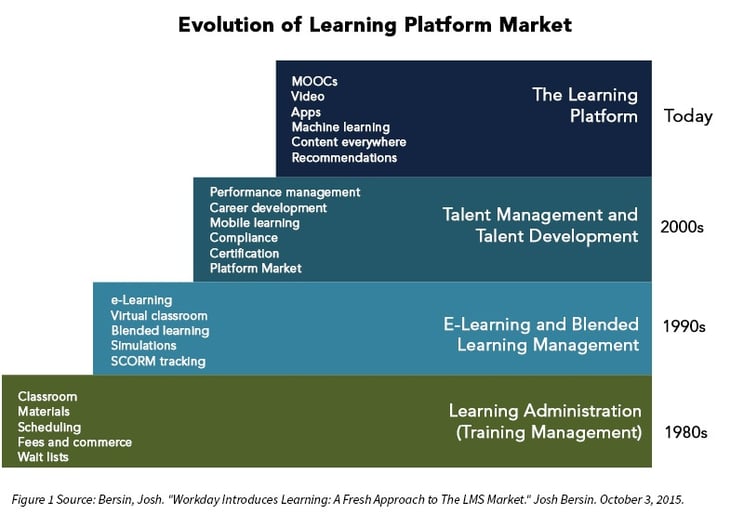
Over the past few months, we have seen a great deal of hoopla about the launch of Workday® Learning. Some analysts predict that this new offering from Workday® will be a market disrupter. Others talk about how Workday® is reinventing learning and development by personalizing the learning experience. Workday®’s marketing communications speak about how Workday® is creating a new learning experience in response to customer demand.
What is really going on?
The LMS market is undergoing a significant shift from learning management to an employee-centric, on-demand learning experience. SAP, Oracle, SumTotal, SABA, Cornerstone, and about 300 other providers are already immersed in updating their offerings keep up with user demand. Workday® is a little late to the party, but we think their execution on the concept will place them in the top tier in a very short time.
When you read Workday®’s communications and product announcements, it becomes apparent that Workday® is responding to two customer demands: (1) learning and development as a native application on the unified Workday® platform, and (2) a personalized, responsive, and engaging user experience.
Let’s first discuss the unified platform.
The Workday® Advantage
From our vantage point, Workday® has three competitive advantages:
- Object-oriented architecture. The company uses object-oriented code retained in computer memory. The underlying database stores object metadata instead of a complex structure of related tables. Workday®’s claim that it makes program changes easier to make than on the Java/JBoss/AJAX/Relational database platforms of the previous decade.
- Single platform. Workday® has been a disrupter since its inception by delivering an ERP replacement on a single code platform, removing the complexity of separate integrated applications.
- Ease of use. Workday® designs its user interfaces on the principles that using a business application should be an engaging experience delivered on any device and that no training should be required to complete a task. Customer reviews show that the company succeeds. We have even seen reviews that describe the experience as “fun.”
Workday® has been offering learning and development for several years through its partners, Cornerstone On Demand and SABA. But no matter how well integrations are done, there is an additional level of complexity for the end user. Workday®’s customers made their wishes known, and the company is responding.
Workday® is in a strong position to capitalize on the evolution of how people use learning technology.
The Evolution of Learning
Learning management systems in the 1980s enabled L&D staff to manage training activities. Since then, LMS technology has gone through two major evolutions and is now well into the third wave. The way people use technology has changed, first in consumer applications, then in business applications. The consumer experience drives dissatisfaction with clunky business software, and vendors and employees respond.

In the 1990s, learning management systems began to deliver e-learning over the internet. The 2000s gave us integrated talent management, with training catalogs and course management linked to performance and development plans.
In today’s connected world, people have become accustomed to finding the information they want when they want it. When they wish to see a “how-to” video, they go to YouTube. If they want information on products, they visit Consumer Reports and other consumer websites. They are getting instant price comparisons, buyer reviews, and companion product recommendations on Amazon.
A Torrent of Content
People want the same experience at work they have on their home computers, and thousands of new startups have sprung up to provide it. Mature providers such as SkillSoft and PulseLearning have already embraced the change. Hundreds of universities stream their courses online for free or for a nominal cost. Learning is now available anytime, anywhere, and on any device.
The role of learning professionals has changed from developing and delivering training to curating a vast stream of content.
As content grows up, so do the platforms that deliver it.
The Contemporary LMS
Ten years ago we were implementing LMS applications that enabled us to map training catalog items to competencies and job roles. With today’s advanced analytics and machine learning, top-tier LMS vendors are beginning to provide the means for the learning platforms to recommend learning paths based on an individual’s behavior.
Today’s e-learning can be delivered in short bursts, called micro-learning, to fit easily into busy schedules. Spaced repetition is increasingly used to increase retention, and looped online assessments ensure that people master the material before they can move on. Game mechanics in e-learning helps people learn faster and retain information better.
Conclusion
While Workday® is not inventing the current trends, the company is in a strong position to capitalize on them and become an LMS industry leader. Their current focus is on video learning delivered with the customary Workday® excellent user experience.
Most companies still depend heavily on their learning management systems to track compliance training. They will need the standard features of learning management in addition to ubiquitous content delivery.
Workday® Learning may be the solution right now for companies who are already investing in the Workday® platform. Others may want to wait a little while for it to mature into a full-featured LMS.
References
Pixentia is an enthusiastic team of individuals, fervent to make lives simpler through effective use of technology. Our mission is to implement solutions that drive business results. Know more insights from our thoughts and experience.


/Data%20Sheets%20Landing%20page%20and%20email%20Images/Human_capital_management_solutions_for_workday.png?width=300&name=Human_capital_management_solutions_for_workday.png)
